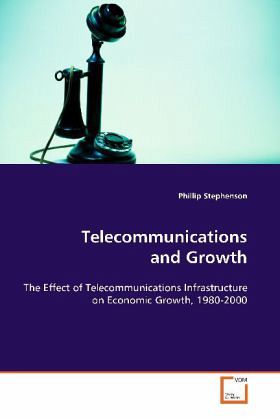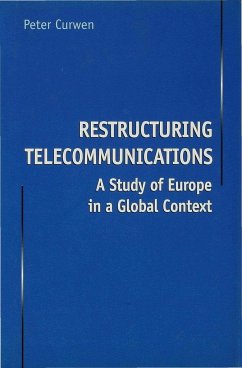
Telecommunications and Growth
The Effect of Telecommunications Infrastructure on Economic Growth, 1980-2000
Versandkostenfrei!
Versandfertig in 6-10 Tagen
32,99 €
inkl. MwSt.

PAYBACK Punkte
16 °P sammeln!
Telecommunications infrastructure is recognized as acatalyst for economicgrowth. The literature has identified howinfrastructure contributes to growth, ways thattelecommunications specifically contributes,and empirically confirmed a significant, positivebi-directional relationshipbetween telecommunications infrastructure and growth.More recently, the technological innovations intelecommunications in the 90s have sparked a debateabout whether these technologies have created a"digital divide." This work reviews this underlyingtheory and the debates surrounding this subject. Data for this analysi...
Telecommunications infrastructure is recognized as a
catalyst for economic
growth. The literature has identified how
infrastructure contributes to growth, ways that
telecommunications specifically contributes,
and empirically confirmed a significant, positive
bi-directional relationship
between telecommunications infrastructure and growth.
More recently, the technological innovations in
telecommunications in the 90s have sparked a debate
about whether these technologies have created a
"digital divide." This work reviews this underlying
theory and the debates surrounding this subject.
Data for this analysis include 79 countries for the
years 1981-2000. The model is regressed using
ordinary least squares, a panel-data method, and
finally it is instrumented to attempt to control for
endogeneity. The instruments utilized in
this investigation prove to be ineffective. The
results of the empirical work confirm
that there is astrong relationship between
telecommunications and growth; that the
technological revolution of the 1990s dramatically
strengthened this relationship;
and that these benefits are biased towards more
developed countries, confirming the
existence of a digital divide.
catalyst for economic
growth. The literature has identified how
infrastructure contributes to growth, ways that
telecommunications specifically contributes,
and empirically confirmed a significant, positive
bi-directional relationship
between telecommunications infrastructure and growth.
More recently, the technological innovations in
telecommunications in the 90s have sparked a debate
about whether these technologies have created a
"digital divide." This work reviews this underlying
theory and the debates surrounding this subject.
Data for this analysis include 79 countries for the
years 1981-2000. The model is regressed using
ordinary least squares, a panel-data method, and
finally it is instrumented to attempt to control for
endogeneity. The instruments utilized in
this investigation prove to be ineffective. The
results of the empirical work confirm
that there is astrong relationship between
telecommunications and growth; that the
technological revolution of the 1990s dramatically
strengthened this relationship;
and that these benefits are biased towards more
developed countries, confirming the
existence of a digital divide.












